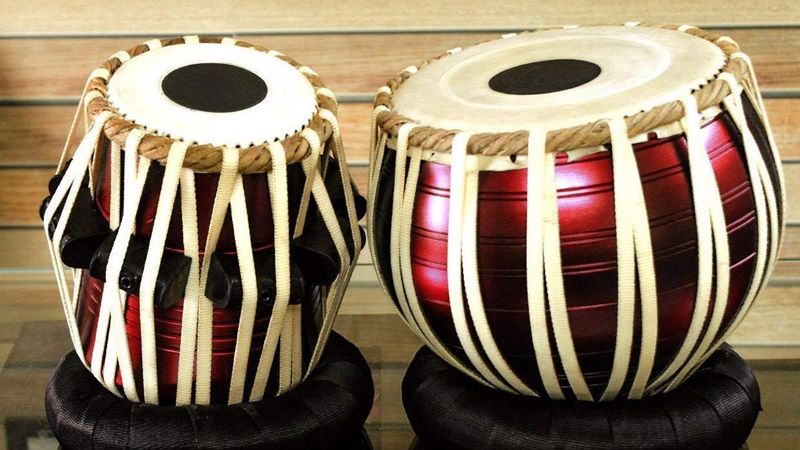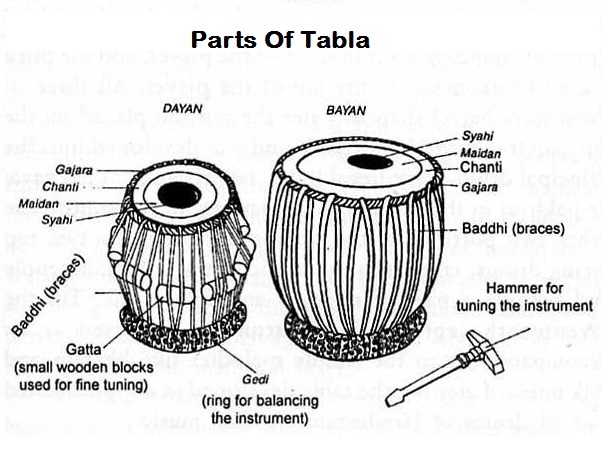Tabla

A set of this Indian drum instrument majorly consists of the following tabla parts: – two drums, the left drum and the right drum.
Dayaa and Bayaa in Tabla Set:
The drum that is played by the right hand is called the ‘dayaa’ (or the table) and the one played by the left hand is called the ‘dagga’ (or the ‘bayaa’).
In them, Tabla has smaller diameter than the Dagga. For that reason, Tabla produces a high pitch sound (treble component). Therefore, many tabla players keep two or more tabla with different diameters to produce different sound pitches.
Quite the opposite, Dagga has a wider top and so produces a more weighty sound (bass component). It is made from clay, copper or brass nickel plated from outside.
Thus are the Parts of tabla instrument. Now, we shall have a look over other tabla parts names.
Various Parts of Tabla Skin Wrappings:
The Tabla and the Dugga are enveloped by a circular piece of goat skin, which is professionally seasoned using some special chemical before being wrapped on the tabla. Thicker this skin wrapping, better is the sound of tabla at higher pitches. This skin covering is called as ‘puri’. In fact, this skin has two layers. The uppermost layer is cut in a circular shape to form the outer rim of the tabla. This is called as ‘Chatti’. The rim or the ‘chatti’ is about ½ inch on the Tabla. In the same way, the round rim on the right Tabla is called as ‘goth’ and to some extent is wider than the chatti of tabla.
Tabla parts (or Dayaa or the Right Hand Drum):
The tabla is made from a block of wood around 12 inches in height. As a rule, heavier the wood – better is the tonal quality of the tabla. The wooden part of tabla is known as the ‘lakadi’ .
The wood is hollowed out from inside for about 4 inches and the rest is block wood. The tabla diameter is smaller at the top and progressively increases towards the lower part. In general, it has 4 to 6 inches diameter at the top and 9 inches diameter at the bottom.
I will explain more about Manufacturing Tabla in next article!
Ink Smearing on parts of tabla:
The black round smearing on both tabla and dagga are called ‘syahi’ (ink). Thicker the ink-coat, lower is the pitch and vice versa. It is a paste from mixture of iron fillings, rice paste and some adhesive to bind it all. This ink is placed centrally on the Tabla, but wildly on the dagga. These ink drops provide the tabla player a chance to change or control the pitch and resonance of tabla.
The part of the original and visible skin wrapping is called as ‘maidan’ or ‘lav’. The outmost ring that attaches the skin to the Tabla body is known as the gajra. This gajra has 16 holes through which the tuning straps are fastened across the tabla and dagga body. Thus, the skinhead firmly connects to the entire body.
The leather straps are called as ‘baddhi’. The ‘baddhi’ are interwoven through the gajra at the top and the bottom. There is a circular hide called the ‘gurri’. It gives stability and the tension in the skinhead.
The round wooden blocks are called the ‘gatta’ or ‘gulli’. When it is dragged downwards, it increases the tension on the skin and lowers the tension when dragged up. The ‘gatta’ is used to tune the tabla.
Adhara(Gadi) for various parts of tabla instrument:
Both the tabla and duggi are rested on ‘adhara’ or Gadi. They are made of straw and are covered with cloth. ‘Addhar’ gives immovability to the instrument while playing and thus the player can effortlessly vary the instrument position, without the worry of falling off.
तबला को भी शास्त्रीय के साथ हर तरह के संगीत के साथ प्रयोग किया जा सकता है। इसका प्रयोग भारतीय संगीत में मुख्य रूप से मुख्य संगीत वाद्य यंत्रों का साथ देनेवाले वाद्ययंत्र के रूप में किया जाता है। इसके दो हिस्से होते हैं, जो लकड़ी के खाले डिब्बे की तरह होते हैं और बजाते समय दोनों के लिए अलग-अलग हाथ प्रयोग किए जाते हैं। दाएं हाथ से बजाए जानेवाले यंत्र को, जो आकार में बड़ा होता है, तबला, दायाँ या दाहिना कहा जाता है। जबकि छोटे यंत्र को जो आकार में छोटा होता है और बाएं हाथ से बजाया जाता है उसे सिद्दा, या बायाँ कहा जाता है। सिद्दा को बजाते समय बाएं हाथ की उँगलियों, हथेली और कलाई का प्रयोग किया जाता है। दोनो यंत्र पुआल के एक गद्दे पर रखा जाता है जिसे छुट्टा कहा जाता है। दोनो यंत्रों के ऊपर बीच में एक काली गोल आकृति होती है जो अक्सर या तो चंदन या एक अन्य काले पदार्थ की बनी होती है जिसे स्याही कहा जाता है। ये काली आकृति चमड़े के छाल के उपर लगी होती है। यह अवनद्ध वाद्य के अंतर्गत आता है।

Tags
- Log in to post comments
- 2629 views
